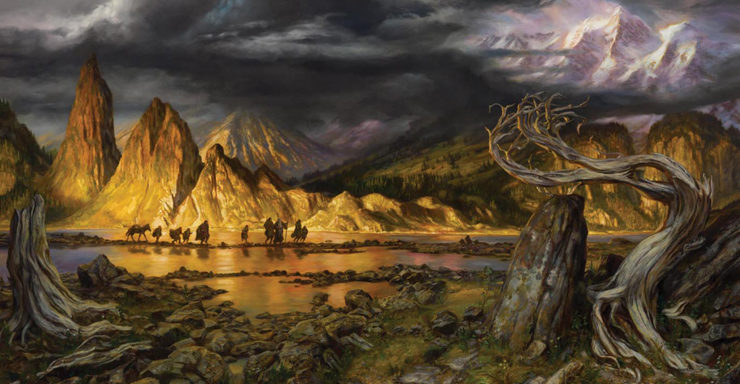Wherein Isildur Pockets the One Ring, the Kingdoms of Men Fall Apart, Wizards Show Up, the Dark Lord Rises Again, and a Halfling Goes On a Big Journey
The second half of The Silmarillion’s final chapter isn’t the end of all things. It’s just the end of this one book, a wrap-up to one of the finest in fantasy literature. Even Tolkien’s most casual readers will find many parts of this section familiar, what with all the sly winks, cameos, and name-dropping. But it’s more than just a massive spoiler about what happens with Sauron’s favorite piece of jewelry: “Of the Rings of Power and the Third Age” overtakes the events of the War of the Ring and brings the story of the Elves to a close. After all, the end of this age also means it’s time “for the dominion of Men and the decline of all other ‘speaking peoples’ in Middle-earth.”
More than ever, I’m going to tie in information from Appendix A of The Lord of the Rings, so as to arrange events in a clearer chronology than the chapter alone gives us. Likewise, The Silmarillion’s sidekick, Unfinished Tales, will chime in to fill in some gaps.
Buckle up, this is a big one. The Primer Installment to End Them All.
Dramatis personæ of note:
- Isildur – Man, Ringbearer, arrow-catcher
- Elrond – Half-elf, loremaster, prospective father-in-law
- Galadriel – Noldo, lady of the Golden Wood, looking glass fortune-teller
- Círdan – Teler, Shipwright, lord of the Grey Havens
- Gandalf the Grey – Maia, Istar, secret agent of the even more Secret Fire
- Saruman the White – Maia, Istar, wizard of nefarious and multifarious colours
- Witch-King – Nazgûl, Morgul-lord, bully
- Eärnur- Man, “last” king of Gondor
- Aragorn – Man, Ranger, returning king
- Frodo – Halfling, Ringbearer
- Sauron – Maia, Necromancer, shadow of malice, shithead
…and The Third Age
It’s now year 1 of the Third Age and the aftermath of the Battle of Dagorlad, where the Last Alliance of Elves and Men had finally thrown down the new Dark Lord—and the forces of darkness were driven forever from the face of Middle-earth. (Kidding.) But at least with the head of the great Mordor snake cut off, the body is useless (mostly); Sauron’s forces are scattershot. His soldiers run off in all directions, but many do live on to trouble Middle-earth, if no longer united under the banner of their Dark Lord. Some Men who fought for Sauron turn away from their evil past and now submit to Isildur, who is the only noteworthy king of Men. Still others grumble and just turn away, hating the Dúnedain and biding their time, waiting for revenge.
Meanwhile, the siege is completed, and the Last Alliance makes sure the fortress of Barad-dûr itself is thrown down (not counting the mezzanine)—though, and this is important, its foundations are not removed. This might be seen as an oversight, but given that the Dark Tower was made strong by the One Ring’s own power, it might be that the Last Alliance simply cannot remove them. The Númenóreans and the Elves might be the most “technologically” advanced people on the continent, but I don’t think demolition is their strong suit.
In any case, Isildur’s got the One Ring now. And right there on the plain of Gorgoroth, Elrond and Círdan advise him to march it on up into the Cracks of Doom and just toss it in. Unmake it now to ensure that the very inhuman spirit of Sauron remains “diminished” forever. But why should he? He, Isildur, had dealt Sauron the blow that vanquished him, and surely he gets the lion’s share of the XP! With the boss monster defeated, its treasure goes to the victor. Isildur calls the Ring his “weregild,” or restitution, for the loss of his father and brother.
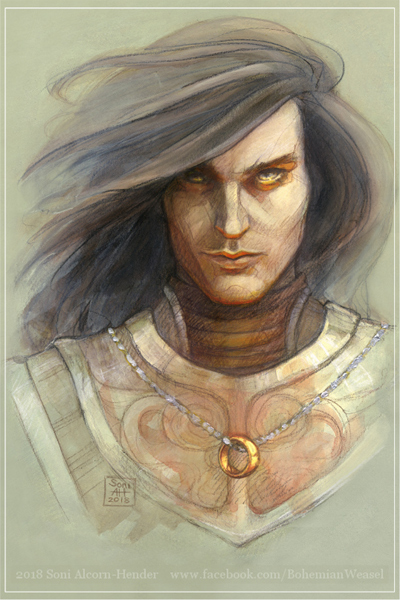
Now, Isildur’s not some evil jerk whose overmastering pride aims to wield the One Ring. He’s the same guy who nearly died just to cut a piece of fruit from the White Tree in Númenor, and he’s done many valorous deeds since. That said, the Ring makes itself precious to him, and “exceedingly fair to look upon,” just as it does to almost everyone who beholds it, and this outweighs the good counsel of two very wise Elves.
Seriously, Elrond is the son of Eärendil the Mariner who circles the world in a blessed spaceship with a Silmaril on his head, and he’s also the brother of the first king of Númenor, from which Isildur is many generations descended. And Círdan? Forget it. The dude was part of the great march of Eldar before the Sun and Moon were even things, and he’s met Maiar and Valar face to face on the western shores of Middle-earth. Oh, and by the way, he also helped to build the aforementioned spaceship. Goddamnit. But yeah, what do they know?
It’s symbolic, maybe, that Isildur’s rejection of this very good advice is kind of where the long estrangement between Men and Elves really begins. With both Elendil and Gil-galad gone (the co-founders of the Last Alliance), things just sort of drift apart. The kingdoms of Men will soon fragment into petty realms, while the already reduced number of Elves withdraw into smaller, secretive resorts.
But first, there is other business to attend to. Isildur takes the Ring with him to Minas Anor, that tower on the west side of Osgiliath, where his late brother used to live. There, just two years into the Third Age, he plants the White Tree’s sapling in its court. Here also he leaves his nephew in charge of Gondor, as Isildur himself is now intent on taking his father’s place as the king of Arnor up north.
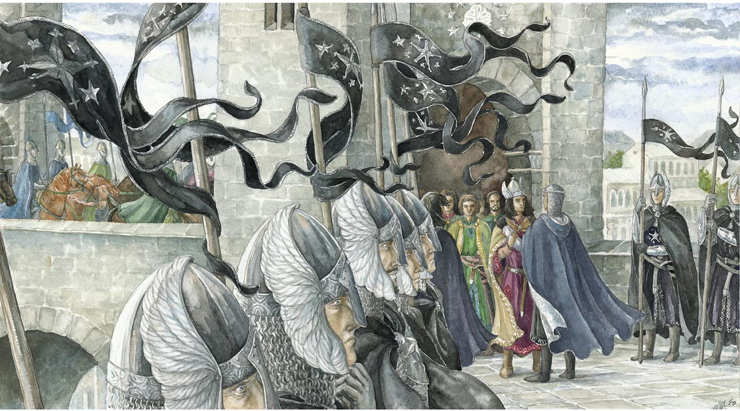
So he heads not northwest—which would be direct passage through the plains that will one day be called Rohan—but rather by the same route his father took in the Last Alliance. His intent is to cross the Misty Mountains further up and pass through Rivendell on his way to Arnor.
It doesn’t go so well.
In brief, the character and precise fate of Isildur is made clearer in “The Disaster of the Gladden Fields” section of Unfinished Tales, where we’re told that he desires to go to Rivendell not merely to pass through and collect his wife and youngest child (where he left them to go to war), but to seek the counsel of Elrond. That’s right, he’s finally ready to take advice from one of the Wise. Why? Because the One Ring has already become a burden to him, though he’s had it for less than two years. And he knows that it should be given to the keepers of the Three Rings.
And so it is near the Gladden Fields, that marshland between the River Anduin and the Misty Mountains, where Isildur’s entourage is attacked by a large band of Orcs. Orcs not under the command of any real leader, but feasibly drawn to the One Ring.

With his own band vastly outnumbered, and only at the insistence of his own sons, Isildur puts on the One Ring and escapes, invisible, retreating to the River. He doesn’t even want to (‘I dread the pain of touching it.’), but his eldest son demands it:
Go! Take your burden, and at all costs bring it to the Keepers: even at the cost of abandoning your men and me!
In pain, Isildur slips it on, and for thousands of years no one knows what happens to him and the One Ring to Rule Them All. But we know that Orcs stalk him like game, the Ring eventually quits him, and while he struggles “amid great rushes and clinging weeds” of the marsh, his hunters see his figure at last in the dark of night. He is struck in the throat and heart by arrows.
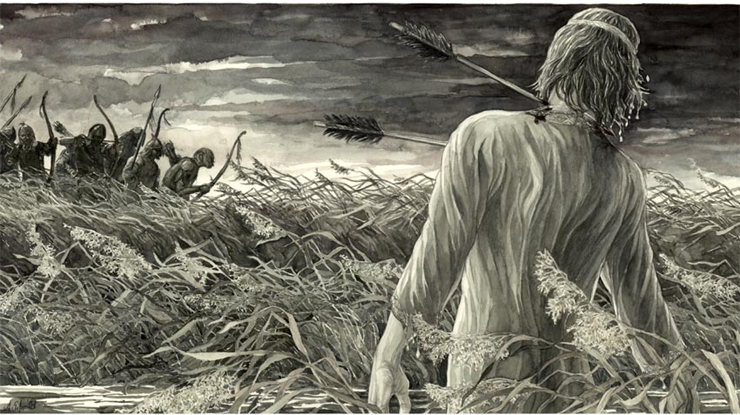
Isildur’s unarmored body drifts away in the water. He gets no grave, no tomb, nor are any of his kingly trappings recovered anytime soon.

Especially not the One Ring, which vanishes into the Anduin, and it’s not like anyone even knows that that’s the place to start searching for it. Meanwhile, only three guys from Isildur’s escort survive that Orc ambush. One of them does have the shards of Narsil in his possession, though, so they’re then kept safe in Rivendell—maybe, just maybe, to be used by the hands of some heir of Isildur’s.
“We’ll see,” Elrond basically says about that. “I mean, only if the One Ring is found again will that even be necessary.”
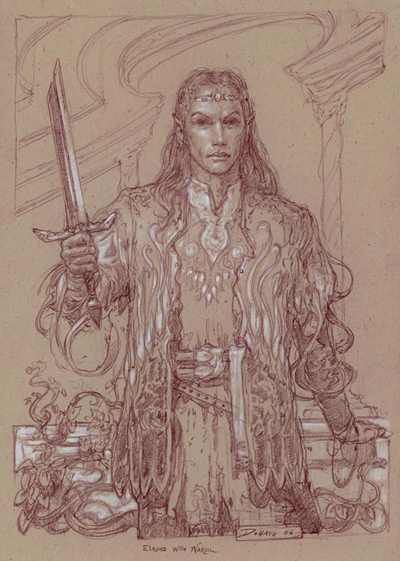
The first such heir is Isildur’s only surviving son, Valandil, who grows up and moves into the capital city of Arnor as its now-third king. But as the years roll on, Arnor declines (as all things do in Middle-earth). It simply doesn’t have the numbers or the influence it once had to maintain all the cities, watchtowers, and other marvelous constructs across its great expanse. Then there’s the general thinning out of Númenórean blood as the Dúnedain mix and match with the not-as-gifted-or-long-lived Men of Middle-earth. So by the death of Arnor’s tenth king, it fractures into three separate smaller kingdoms: Arthedain, Cardolan, Rhudaur. Each one of them is ruled by one of that king’s squabbling sons.

Gondor fares much better than these northern kingdoms and even flourishes and grows stronger again for quite a while, starting with the reign of Isildur’s nephew and running for more than thirty more kings before the royal line stops short. We’ll come back to that. Meanwhile, that seedling that Isildur planted anew in the court of Minas Anor actually gets to grow and last a good long while.
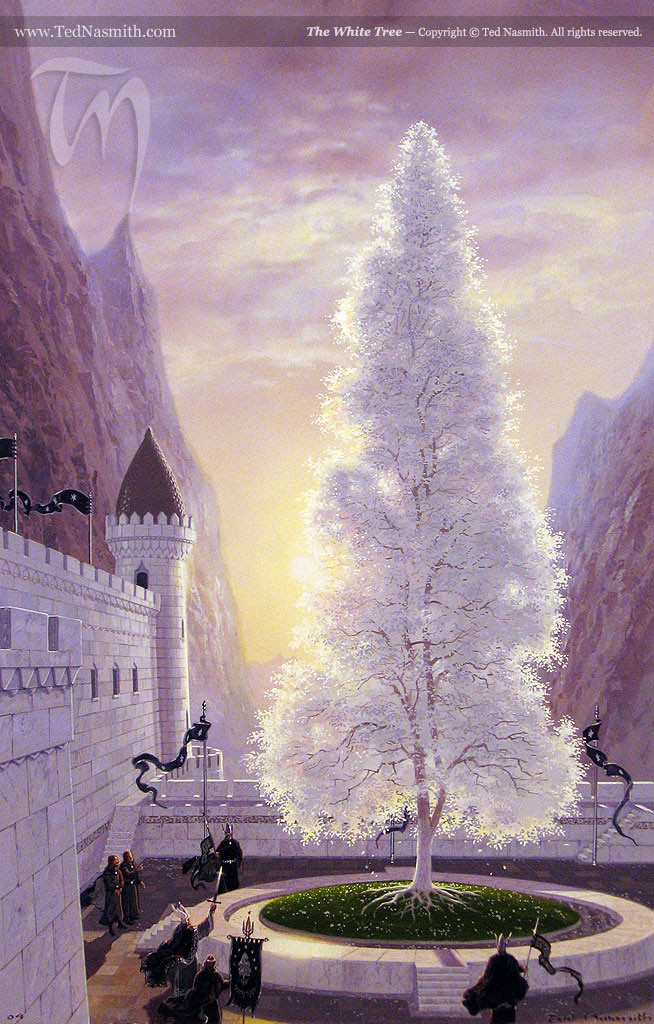
For 1,634 years, in fact! But it will eventually wither—coinciding with a terrible plague that sweeps through the land. Fortunately, another seedling will be planted. But then that one will die, too…1,232 years later! And then that’s it, no more seedlings. Bummer.
Okay, but what about the Elves? Well, as the centuries go by, the old friendships—even basic relations—between the kings of Men and the Elves fades. There aren’t all that many Elves left, for one, and they continue to live on in smaller enclaves and havens, ageless and immortal. Whereas the lives of Men are short, fleeting, and the lives even of the Dúnedain gradually shorten. The Firstborn and Secondborn Children of Ilúvatar become estranged, and the stranger something is, the more it is feared.
Since Sauron has been vanquished and his Ring mislaid, the keepers of the Three Rings are actually able to use them safely. So they dig them out of hidey-holes, fish them out from between couch cushions, or wherever the Wise tend to stash Rings of Power. They are finally able put them back on again, to use the Three as Celebrimbor intended! Thus their extraordinary powers of preservation strengthen the presence of the Elves in the Third Age, based on where they’re used and by whom. Without the Three Rings, which Celebrimbor chanced to make, the Elves would surely have a much smaller role to play in the War of the Ring (which at this time is still very far off).
I mean, if chance it was.
Rivendell is pretty much Elf-central now, a “refuge for the weary and the oppressed” on Middle-earth, the Last Homely House where friendly fires burn and both the memory and literal relics of the past are preserved by Elrond. Here, the Dúnedain and especially the heirs of Isildur have a place to crash. Here there is wisdom and healing in abundance. Vilya, the blue Ring of Sapphire and the mightiest of the Three Rings, helps Elrond’s estate to be its best self.
It’s like a Canadian once sang:
You feel there’s something calling you
You’re wanting to return
To where the Misty Mountains rise and friendly fires burn
A place you can escape the world
Where the Dark Lord cannot go
Peace of mind and sanctuary by Loudwater’s flow
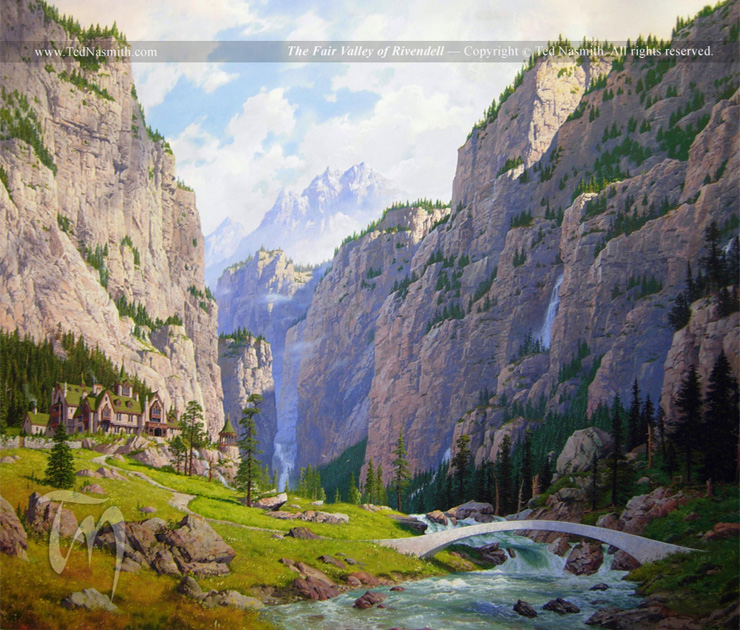
Oh, and Elrond gets hitched! He’s met a lovely Elfmaid, Celebrían, who just happens to be Galadriel’s daughter (making her mostly Sindarin but with some Noldorin and Vanyarin blood). After a nice twenty-one-year honeymoon—no doubt right there in Rivendell, holding down the fort—Celebrían gives birth to twin sons. Elrond and Celebrían take an eleventy-one-year break, then have a third child: one Arwen Undómiel, who bears an uncanny resemblance to her ancestress, Lúthien.
Meanwhile, on the west end of Eriador, Círdan holds down his own fort as the master of the Grey Havens. Not only does he still oversee Middle-earth’s Elven emigrants, he’s the keeper of Narya, the Red Ring—but only for a little while (just the first thousand years of the Third Age). Being the world’s preeminent shipwright, Círdan’s not exactly the ideal candidate to bear the Ring of Spiritually or Literally Setting Things On Fire. So he doesn’t use it. He bides his time, protecting Lindon, with eyes often looking West.
On the east side of the Misty Mountains there are two notable Elf-lands, and they’re even more aloof from mortal lands. In the forest of Greenwood there is the Woodland Realm, where Thranduil rules as king of the Wood-elves. His people, at least, will eventually have some commerce with Men (Dale and Laketown), but for the most part they’re an insular bunch. Only Unfinished Tales tells us that Thranduil’s own dad had fought and died in the Battle of Dagorlad, there among the Dead Marshes.
Lastly, there is Lórinand, which joined in the wars against Sauron in the Second Age, but when its weary king departs for Valinor in the Third, Galadriel and Celeborn are left in charge—the former no doubt stoked to have a place of her own to rule. And so this is the forest-realm that becomes Lothlórien; Galadriel alone would have been familiar with the original Lórien in Valinor, home of the married Valar of dreams and quietude, and which inspired this, its Middle-earthen reflection in name and spirit.
From Gil-galad (who in turn received them from his Númenor friends of old) she received the seeds to plant those giant mallorn trees we read about in The Lord of the Rings. The mallorns that give the Golden Wood its signature look. They grow nowhere else on Middle-earth, and probably only due to Galadriel’s own power—enhanced greatly by Nenya, the white Ring of Adamant. With her watery Ring of Power, she preserves the beauty of Elvendom in Lothlórien, cooks up the scrying power of her namesake Mirror, and I guess keeping the drinking fountains running cool and refreshing?

Just about a thousand years into the Third Age, when Gondor is still strong but Arnor has already fractured, some mysterious boats arrive at the Grey Havens. In them are some bearded, staff-wielding senior citizens who look a lot like Men but sure aren’t. These are, of course, the Istari, the color-coded wizards of Tolkien’s legendarium, and arguably the most dynamic geezers on Middle-earth. Well, two of them, at least.
Very few individuals will ever know who these guys really are, but Círdan is there to welcome them. He knows what’s up—or will, soon enough. The Istari are Valar-chosen Maiar sent to Middle-earth with a clear objective (contest the power of Sauron) but under some restrictions on how to achieve it (namely, in a low-key fashion). The first wizard to arrive is Curunír, a.k.a. Saruman, a Maia of Aulë, who actually volunteered for the task. He wanted to come. We’re also told he is the oldest of the Istari, which means Ilúvatar must have thought him up in the Timeless Halls before the others, if that makes any sense. Then comes Radagast, a Maia of Yavanna, along with two others not named in The Silmarillion (but they’re Alatar and Pallando). Tagging along as the fifth is a Maia we were expressly introduced to back in the Valaquenta: Olórin, a.k.a. Gandalf, Mithrandir, the Grey Pilgrim. Stormcrow!
Círdan quickly pegs the importance of this last one; he’s an excellent judge of character. And not only does he know that these gentlemen are Maiar on a mission, he has the wisdom and foresight to know that Mithrandir is the right man for the job of bearing the Ring of Fire. So Círdan gives it to him…
for thy labours and thy cares will be heavy, but in all it will support thee and defend thee from weariness. For this is the Ring of Fire, and herewith, maybe, thou shalt rekindle hearts to the valour of old in a world that grows chill.
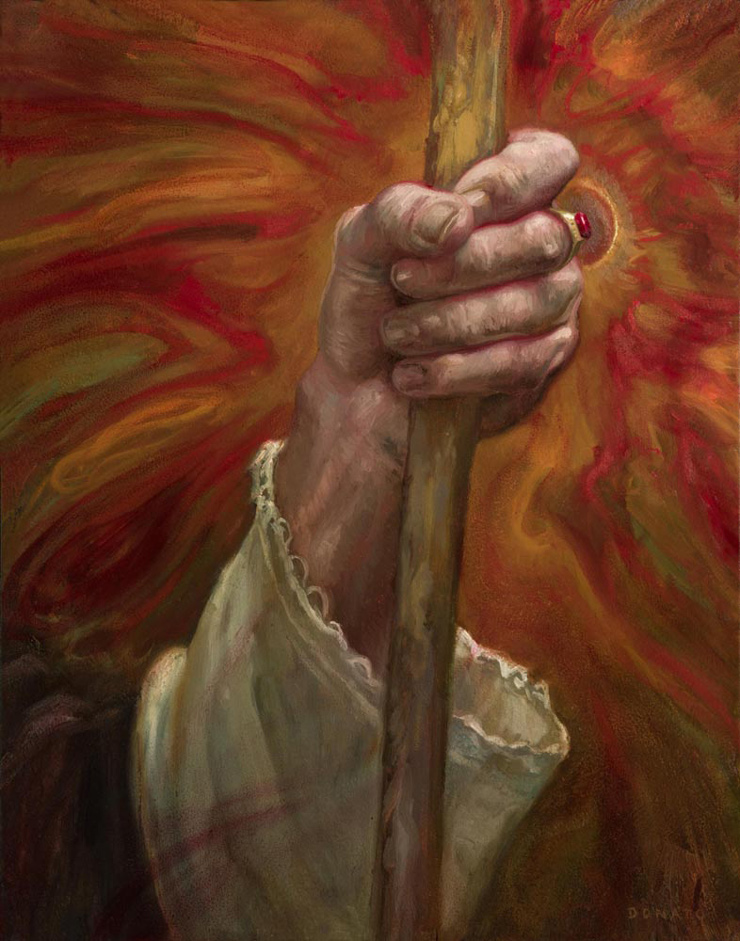
The wonderful Istari section in Unfinished Tales is one of the few places where it’s made quite clear that the Valar know they made some missteps in the handling of the Elves way back when. Here is the specific wording, and it’s presented in one windy but informative sentence that also gives us a clear mission statement for the wizards:
And this the Valar did, desiring to amend the errors of old, especially that they had attempted to guard and seclude the Eldar by their own might and glory fully revealed; whereas now their emissaries were forbidden to reveal themselves in forms of majesty, or to seek to rule the wills of Men or Elves by open display of power, but coming in shapes weak and humble were bidden to advise and persuade Men and Elves to good, and to seek to unite in love and understanding all those whom Sauron, should he come again, would endeavor to dominate and corrupt.
The Istari have not only been picked by the Valar, the whole operation has got the Ilúvatar stamp of approval. Five wise and divinely-fueled wizards (in one Unfinished Tales passage, it’s suggested there might even have been more than five) is surely enough to contend with Sauron, who is himself a Maia. But as we’ve seen before, not all Maia are equal in power.
Fascinatingly, also from Unfinished Tales, we learn that Olórin is reluctant to go at all. He feels he’s too weak; moreover he fears Sauron. Which makes Manwë want him for the job all the more. It’s almost like above all, Gandalf is the most motivated to succeed, and will take the task all the more seriously. Given that he ends up being the only wizard (or nearly so) to carry out the mission, it sure is good Manwë chose him.
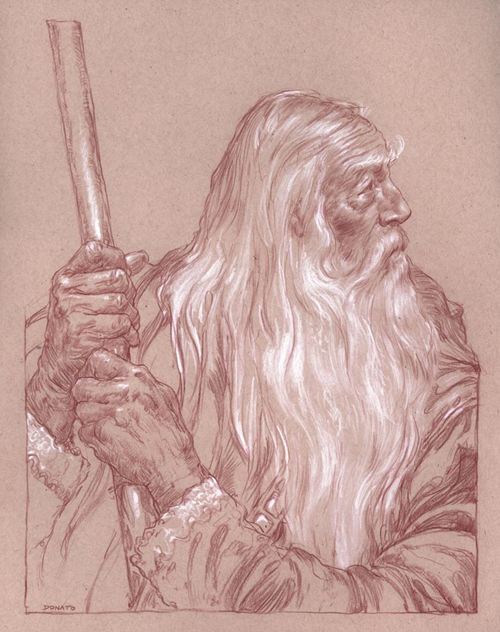
Not long after the arrival of the Istari, Men in and around Greenwood the Great start calling this forest by a new name, on account of it getting darker and scarier. Now it’s Mirkwood, everyone: buy new maps!
Buy the Book
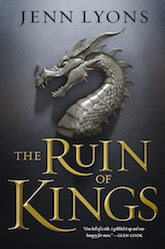

The Ruin of Kings
And right around the same time, Eriador is blessed by some rather diminutive immigrants padding quietly over the Misty Mountains from the northern regions of the Anduin. They’re shorter than Dwarves but way fonder of eating. These are the Periannath (which is Sindarin for “Halflings”), and they’re most likely a heretofore unknown branch of Mankind. But that in itself shouldn’t be a surprise. Flying under the radar, and staying out of the considerations of the great and wise (well, most of them) is kind of what halflings do. Anyway, they migrate westward, group by group, until they eventually settle into the idyllic and fertile hills of Arthedain (one of those three squabbling kingdoms that were formerly a part of Arnor).
So yeah, Hobbits are now on the scene. Everyone can relax. They got this.
Well, all right…not just yet. It’s the Istari who are here to help…and then they promptly go their separate ways. The two blue wizards disappear in the East, leaving us to wonder if they ever do anything at all; or maybe their work keeps Sauron’s flunkies in the East from doing even greater harm than they’d intended. Radagast the Brown is futzing around with nature and generally being idle. This leaves Saruman the White and Gandalf the Grey to deal with the whole contest-Sauron thing. Saruman also ventures out East but eventually circles back and falls into the study of the Rings of Power. Unsurprisingly, as a fellow Maia of Aulë, he’s into the devices and methodologies of the Enemy.
Gandalf, meanwhile, just does what Gandalf does best. He rambles on, “a stone doomed to rolling,” always listening and watching. He definitely puts to good use the pity and patience he’d learned in the house of Nienna back in the Valaquenta. And maybe with his shiny new Ring of Fire he’s rekindling some hearts—maybe even tossing the odd pinecone-fireball at a warg now and again? And let’s not forget the mysterious Tom Bombadil, with whom Gandalf seems to be acquainted. I bet he stops in and has some chats with him from time to time. Tom may be a “moss-gatherer,” but he’s been around a helluva long time and knows a thing or two about what’s natural and what’s not in Middle-earth.
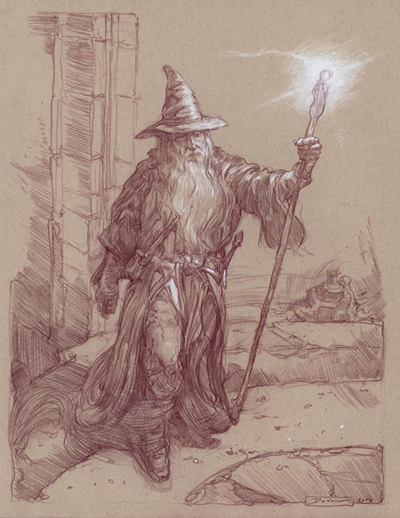
And so it’s Gandalf who first gets a bee in his bonnet about Dol Guldur, an old hill-fortress that used to be the Wood-elves’ capital, but is now long abandoned. It seems an evil something has taken up residence there, and it’s clearly responsible for mirking up the all woods of the forest formerly known as the Greenwood. There’s no name to associate with this sinister presence, but based on rumors alone it’s earned the creepy-ass title of the Necromancer.
The Wise think this might be one of the Nazgûl, which makes sense; the Nine Rings given to Men not only turned them into wraiths, they gave the Dark Lord’s lackeys sorcerous power of their own. Now, the Nazgûl have been pretty low-key since Sauron’s defeat but they’re starting to pop up again, and that doesn’t bode well. Gandalf adopts a persistent let’s-check-out-Dol-Guldur policy from here on out when discussing the matter with his peers, and ultimately he’s the one who goes nosing around the place.
But then the chief of the Nazgûl, the so-called Witch-King, sets himself up as the head of a new kingdom in the north: Angmar. It becomes the first organized realm of baddies since the Dark Lord’s great defeat (at least, this side of the Anduin). Granted, Angmar is no Mordor, but given how weak Eriador’s people have become, it’s trouble enough. Those three kingdoms of bickering, fading Dúnedain now have the Witch-King gnawing at them at all times. Just great.
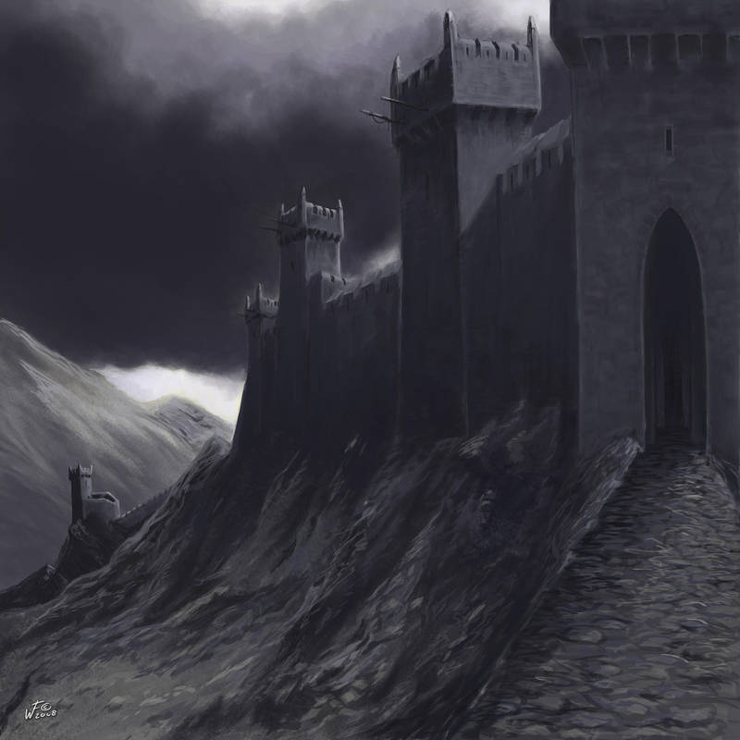
Even Rivendell is harassed. That’s right, Angmar dares to attack the Last Homely House. But its master, with his Ring of Power and his loyal tra-la-lally Elves, keeps even the Witch-king off his lawn. It would be amazing if Elrond had shouted after him with a shaking fist: “You trespass again, I’ll wash you down the river!”
But the watchtower of Amon Sûl (Weathertop), which because of its palantír had been a point of contention between the Dúnedain’s petty kings, gets creamed by the forces of Angmar. Then the Witch-king and his armies run roughshod over the rest of the north kingdoms. The former capital of Arnor has already been abandoned, but now its successor, the city of Fornost, is taken by Angmar as well. Things are not boding well, indeed; Rhudaur and Cardolan are all smashed by Angmar, so it’s just Arthedain left.
Yet even in these days of turmoil, those Hobbits who’d migrated into Eriador finally come into their own. They seek permission from the king of Arthedain to officially settle in those lush hills east of the Grey Havens, and they receive it. The Shire is thus founded around the year 1600 of the Third Age. The Hobbits even do their part—or at least they’ll claim to—by sending some archers to help out against Angmar. Whether that helps or not, for thousands of years, until Bilbo and Frodo really put it on the map, the Shire is basically flyover country (ridepast country?) in Middle-earth.
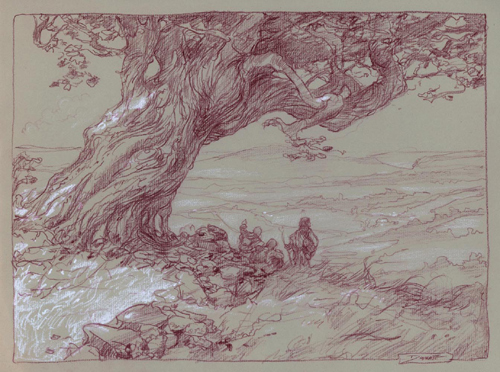
And they’re just fine with that. Adventures and wars make you late for dinner!
So one question is: where was Gondor when Arthedain and the other north kingdoms fell? Well, they have their own troubles, but they do send help and it does makes a difference. Gondor’s thirty-third king, Eärnur, is one worth knowing about for a couple of reasons. One, he’s the last king of Gondor before the Stewards have to step in to govern in their stead. But two, there’s an anecdote related to him that’s buried in the Appendices and worth pulling out for Lord of the Rings reasons.
When Eärnur (AY-er-noor) is still just a warrior-prince, his dad sends him with a fleet of Gondorians up to help Arthedain with its Witch-king problem. The Elves of Lindon join in, too. So Eärnur fights alongside such Elven celebrities as Círdan and Glorfindel…yes, the Glorfindel, the same Noldorin lord who gave his life at the fall of Gondolin but got re-embodied in the Halls of Mandos and then got shipped back to Middle-earth some point since.
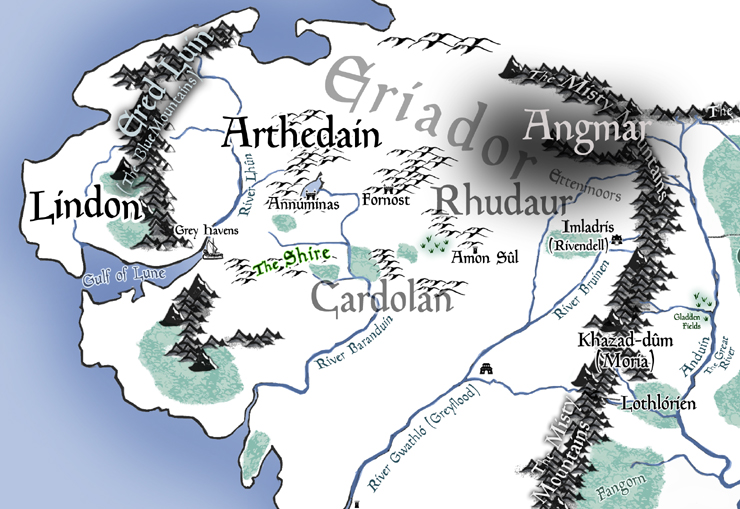
Well, even as Angmar’s forces are cut down by its collective foes, Eärnur gets the Lord of the Nazgûl’s personal attention. His personal hate. So the Witch-king calls him out, and Eärnur charges in, intent on single combat with the chief of the Nazgûl. He makes a beeline, ready to take him on, man-to-wraith. But Eärnur’s horse (understandably) freaks out in close proximity to the Nazgûl and he’s forced to retreat in front of everyone, in humiliation. When Eärnur tries to circle back to wipe the smug-yet-horrifying laughter out of the Witch-king’s mouth, Glorfindel restrains his mortal friend. The Elf then spouts a famous prophecy:
He will not return to this land. Far off yet is his doom, and not by the hand of man will he fall.
Ah, Calaquendi and their foresightedness. But c’mon, this prophecy is truly badass, given its later conclusion.
The Witch-king escapes, but his armies are finished off at Fornost by this actual “last alliance” of Men and Elves. Thus Angmar and Arthedain come to their ends at around the same time. And although Eärnur burns for a grudge match, he returns to Gondor and becomes its last king.
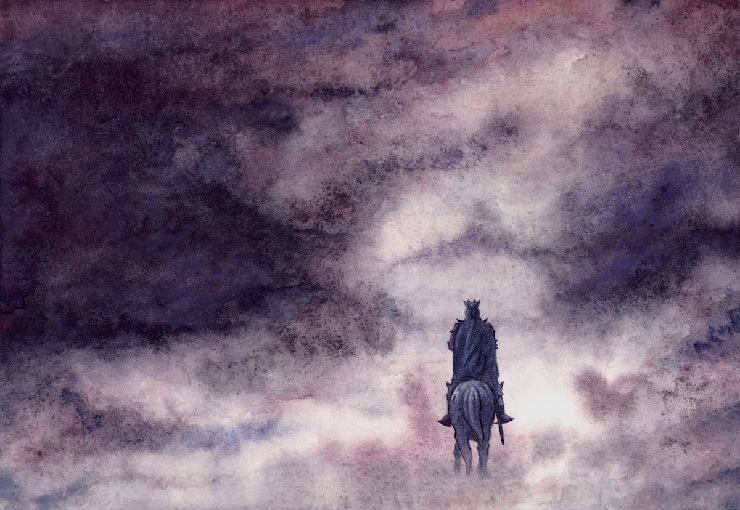
The Witch-king puts his Angmar days behind him, though, and shows up in Mordor, where he gathers together the other eight Ringwraiths (though a few are also later sent back to keep an eye on things in Dol Guldur). Now Mordor, still bereft of its Dark Lord but growing uncannily strong again, flexes its muscles and captures that old tower of Minas Ithil—the one right on its border, where Isildur had once lived. And yikes, this means Mordor now has its own palantír….
And in fact, this is when the Seeing Stones—that is, those still accounted for—are left alone. They’re no longer safe. There is doubt as to whether the palantír in Minas Morgul was destroyed or actually captured by Sauron’s servants. So with that in question they all fall out of known use.
Well, Minas Ithil is renamed by its new occupants to Minas Morgul, and thus the Witch-king gets a fancy new moniker: the Morgul-lord, morgul being Sindarin for “black arts.” But since the bad guys rebranded that tower, Gondor responds by rebranding Minas Anor to Minas Tirith—yes, a callback to Finrod’s watchtower in the First Age, which shares its name. By this point, the former capital city of Gondor, Osgiliath, has already fallen to Mordor’s attacks. So now Minas Tirith really is the foremost bastion against Mordor’s aggressions (as it is still in The Lord of the Rings).
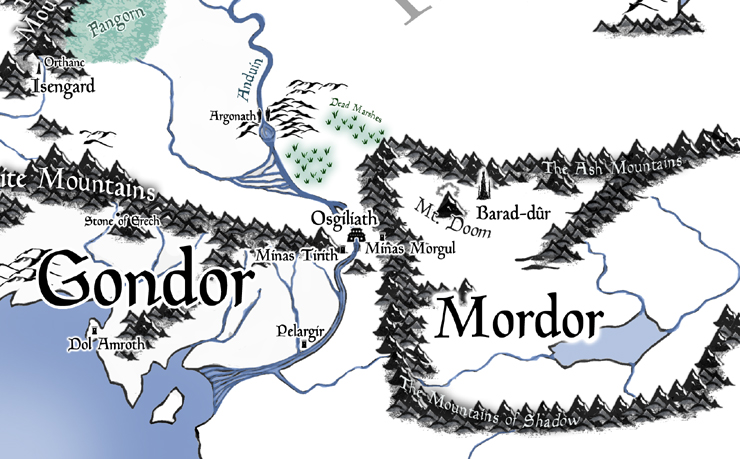
Then the Nazgûl chief sends out a challenge to King Eärnur to come and face him in single combat—for real this time LOL. Though Eärnur wants to answer it, his wise Steward restrains him. Seven years go by and the Morgul-lord renews the taunt. Is the King of Gondor chicken or what? Alas, this time Eärnur rides out alone right up to the gates…and of course the Witch-king cheats and has him captured, tormented, and eventually slain. Because why wouldn’t he?! So much for a fair fight. (Hey, remember when Morgoth’s emissaries pulled the same basic stunt on Maedhros?)
Thus the Stewards are left in charge of Gondor, figuratively keeping the throne warm for the return of…well, any king, any Númenórean descendant with legitimate claim to the throne. There simply aren’t any in Gondor these days, and even if there was someone up there in the broken north kingdoms, they’ve become scattered, “a strange people wandering secretly in the wild.”
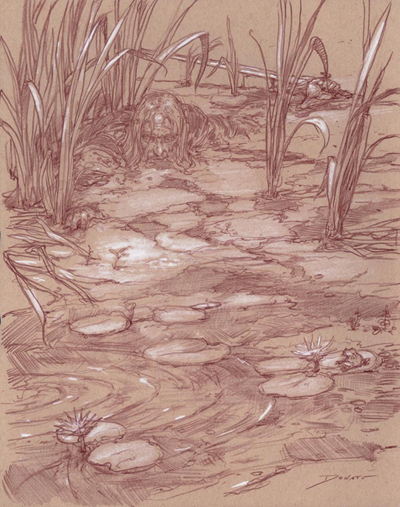
In other words, Rangers! They are a disregarded or even disdainfully regarded folk. So secretive! What are they up to!? But only the Dúnedain themselves and the Elves of Rivendell will remember who they are.
Now, this is a good time to wonder, hey, whatever happened to the Dwarves? Didn’t a bunch of them fight in the Last Alliance? What are they up to during all this? Well, they’ve been centered in Khazad-dûm (Moria) ever since, keeping their noses out of everyone else’s troubles, delving for that sweet, sweet mithril. And staying shut in their mountains have kept them safe for a while now. But, alas, under the reign of King Durin VI, they delve too deep…
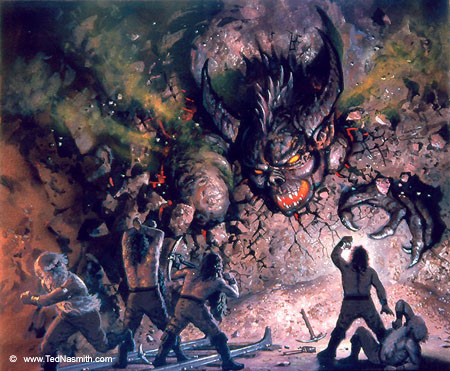
So that’s where the Balrogs ended up! Well, just one of them, anyway! This ancient spirit of fire has just been snoozing in the deeps of the earth ever since the War of Wrath. I suppose it’s little surprise that some would choose to hide out below the mountains reared by the OG Dark Lord long ago. But in seeking mithril the Dwarves have accidentally unearthed this horrific First Age monster, so a whole lot of them are slain—most notably Durin VI. One might connect the dots between this misfortune, the greed for precious metals, and one of the Seven Rings worn by Moria’s king…
of which evil enough after came to the profit of Sauron. It is said that the foundation of each of the Seven Hoards of the Dwarf-kings of old was a golden ring
I think it’s important to understand that good intel about this Balrog catastrophe doesn’t make it out into the larger world. Even the Elves of Lothlórien aren’t sure, calling it only the “Nameless Terror.” All people know is that something bad went down in Moria and now Orcs are squatting there. The Dwarves become refugees, scattering to various mountains holds—some to the Grey Mountains, some to the Blue. But one of Durin’s own heirs wanders east and founds the kingdom of Erebor, becoming the first King Under the Mountain. Yay, the Lonely Mountain is now on the map!

They also find the Arkenstone deep beneath the roots of the mountain. Now this remarkable jewel is no hallowed Silmaril (no!), but the Arkenstone sure means a lot to the Dwarves. Fortunately, there’s no accompanying Balrog lurking down there—so it looks like they’ll probably be untroubled by giant monsters.
Good on them! The Dwarves get a breather.
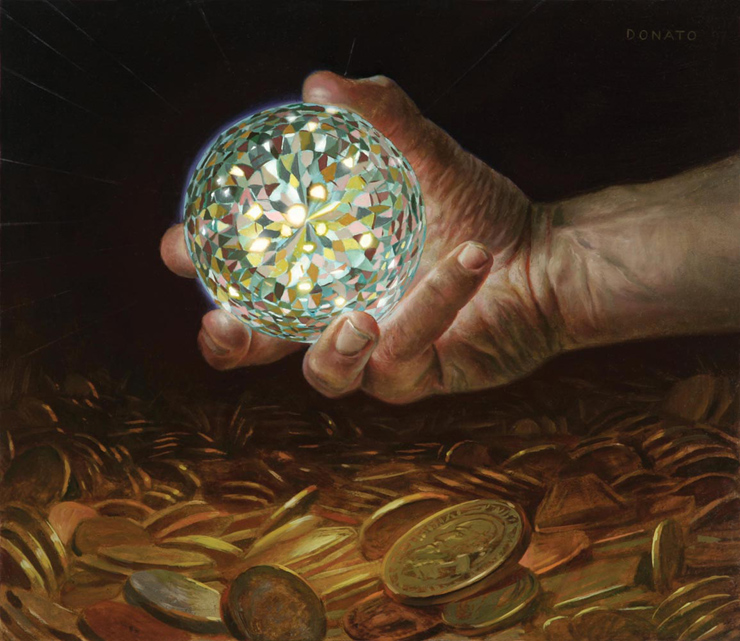
Now let’s go back to that Hill of Sorcery they call Dol Guldur in southern Mirkwood. You know, the one where Sauron has totally been hanging out. Well, now Gandalf actively goes there to snoop around—a risky venture, given his Istari restrictions, but if it’s just a Ringwraith as he thinks it is, he should be able to handle it.
Yet with one of the Wise sticking his nose where it doesn’t belong, Sauron is forced to slip out the back door. The Dark Lord’s trying to make a comeback here, and he can’t have these Wise guys all up in his business. He’s far from ready to return in might; he’s been playing this like a chess master doing his best to move his pawns (Orcs and evil Men) and knights (Nazgûl) around the board while remaining contained and hidden himself. Whereas in his heyday, Sauron was more like a king and queen combined, able to barrel over any foe personally when needed.
Once Sauron flies the Dol Guldur coop—far out East where he can’t properly coordinate his servants—there’s a long period of relative stability in the land. This is the Watchful Peace. I love that it’s Gandalf meddling in the Enemy’s affairs that initiates this long peace. Yet when it ends nearly four centuries later, it’s because Sauron sneaks back into Dol Guldur (through the bathroom window or maybe through a cellar door?) and directs his servants again.
Then some seriously momentous stuff happens.
For one, a river-dwelling, Hobbitish fellow named Sméagol finds the One Ring in the shallows of the Anduin (rather, murder-takes it from his cousin who found it). Sauron’s lost prize really didn’t drift that far from where it split with Isildur, did it? Which is so delightfully close to where he’s lairing right now in Dol Guldur, and yet the Dark Lord is totally unaware. He’s still not strong enough to sense it or arise with greater power. And so Sméagol keeps it, uses it like crazy, and devolves into the loveable scumbag we all know as Gollum. Gollum finds a new home in the Misty Mountains, taking it further under the radar than it already was.
Also around this time, the White Council is formed. It’s an exclusive club of ancient and high-profile elites, which includes Saruman, Galadriel, Elrond, Círdan, and Gandalf, who basically agree to keep an eye out for Sauron’s return and work to oppose him. What with the Istari having mostly scattered, the White Council is sort of like their unofficial replacement. It meets infrequently, talks a lot, but doesn’t necessarily take much action. Gandalf pushes it to do more, but usually it’s Saruman, who is head of the Council, who holds it back.
And that’s because Saruman is kind of a know-it-all jerk, or gearing up to be one. He hasn’t fallen to evil yet, but the more he learns about Sauron the less he wants to merely defeat him and the more he wants to replace him entirely. Interestingly, he’s not living in the tower of Orthanc just yet. He’s still out and about, probably moving from one big house to another among Men.
And speaking of Men: with Arnor long gone and Gondor faltering a bit, the boundaries of the southern kingdom are a little shaky. Fortunately, there are some scrappy horsemen on the scene who help Gondor deal with persistent invaders—usually Orc raiders from the Misty Mountains, but also plenty of troublemaking Men who weirdly preferred the tyrannical yet trains-running-on-time regime of Sauron. For this timely assist, the Steward of Gondor gives these horsemen free ownership of the plains of Calenardhon, which lie on its northern border, just over the White Mountains.

The first ruler of this rebranded landscape is one Eorl the Young and his new kingdom is called Rohan, or the Riddermark (“land of the riders”). Enter the Rohirrim! Woo! These people are actually descendants of the Men who didn’t go as far as Beleriand in the First Age but were part of the same kindred who went on to become the Elf-friends—the Edain! So they’re like very distant cousins to the Men of Gondor.
Anyway, they’re totally going to be best buds, Rohan and Gondor. And their shield-maidens are going to be especially badass, just you wait and see.

Speaking of Orc-raiders, one day Elrond’s wife, Celebrían, is captured by some when she is traveling between Rivendell and Lothlórien (to visit her parents, Galadriel and Celeborn). Though she is tormented by the Orcs, her sons rescue her and she is brought back to Rivendell for healing. But she suffered too much at her captors’ hands. There is insufficient therapy in Middle-earth to help her, so she soon after sails to Valinor, leaving her husband and children behind until their time to sail West comes. It’s a testament to his commitment to helping Middle-earth that Elrond doesn’t hand off his Ring of Power to someone else and go with his wife. Poor guy. Elrond’s family has more reasons than most to hate Sauron.
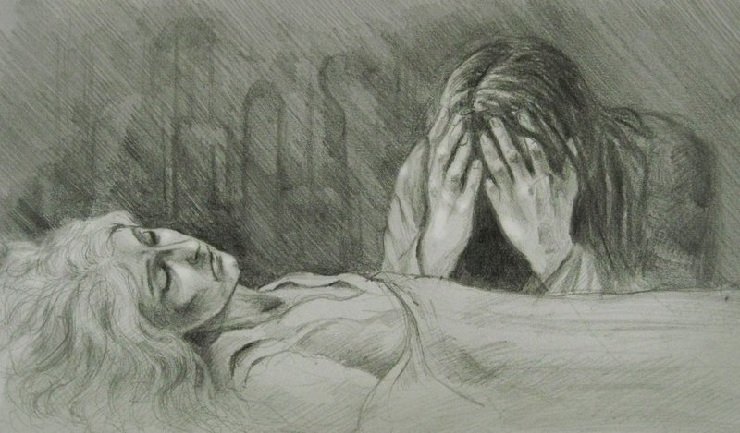
Meanwhile, up by the corner of Gondor and the Misty Mountains, Isengard gets a new tenant: Saruman. He actually signs on as a lieutenant of Gondor, a sort of border security specialist, and the Steward gives him the keys to the black-stone tower of Orthanc. And as Appendix A tells us, “in this way Saruman began to behave as a lord of Men.” Which is kind of not okay for one of the Istari, and yet no one calls him out on this. He’s still the head of the White Council and has the respect of his peers. He has a persuasive voice.
He still seems to be aboveboard.
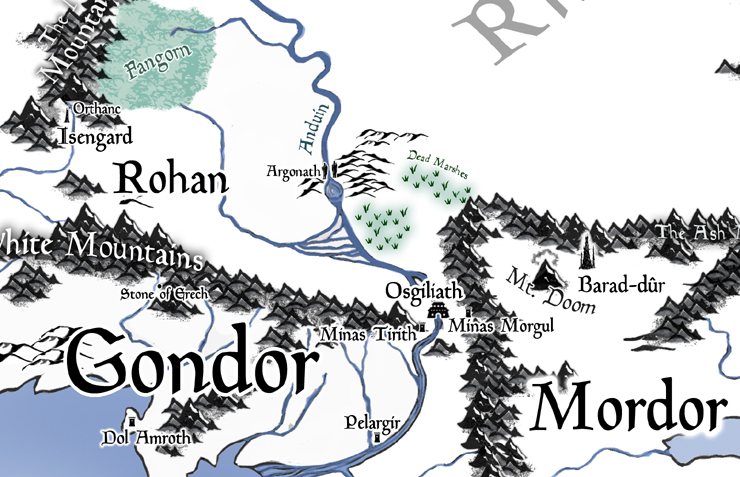
Oh, and inside Orthanc is one of the palantíri. A fortuitous treasure? Well, no. Also from Appendix A:
Though afterwards there was little doubt in men’s minds that Saruman went to Isengard in hope to find the Stone still there, and with the purpose of building up a power of his own. Certainly after the last White Council (2953) his designs towards Rohan, though he hid them well, were evil.
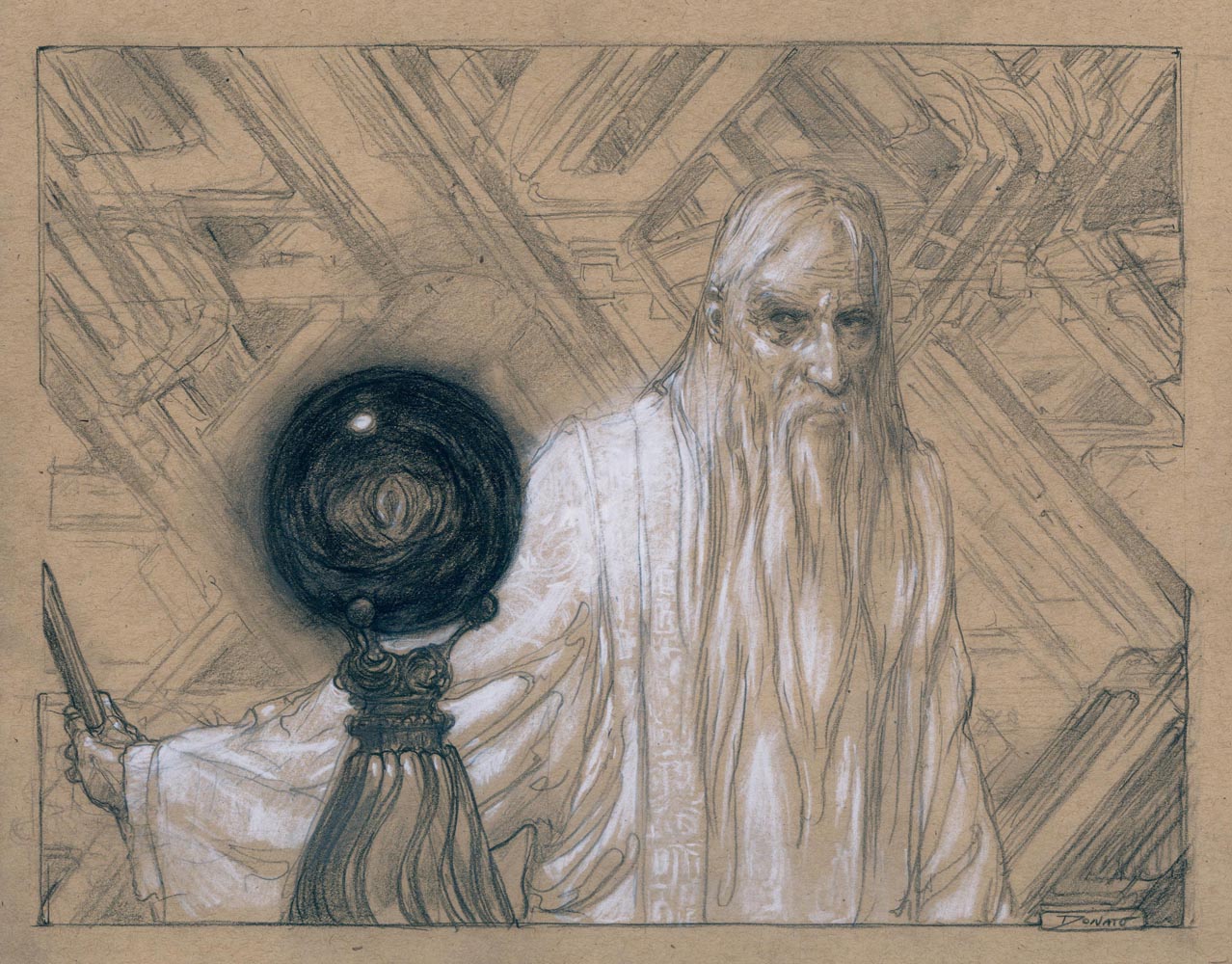
Now, about forty years after Saruman moves into Isengard, that newer Dwarf kingdom based in the Lonely Mountain is, sadly, troubled by a giant monster after all. Fortunately, it’s not a Balrog this time. But unlike a Balrog, this creature has wings.
An uppity fire-drake from the mountains, who’s heard of Erebor’s fabulous wealth, comes swooping down from the north with fire and greed. This is the progeny, maybe, of one of those Angband dragons that survived the War of Wrath. He’s winged, after all. Thus Smaug the Tremendous destroys the city of Men near the mountain and claims the Lonely Mountain and its great treasures as his own.
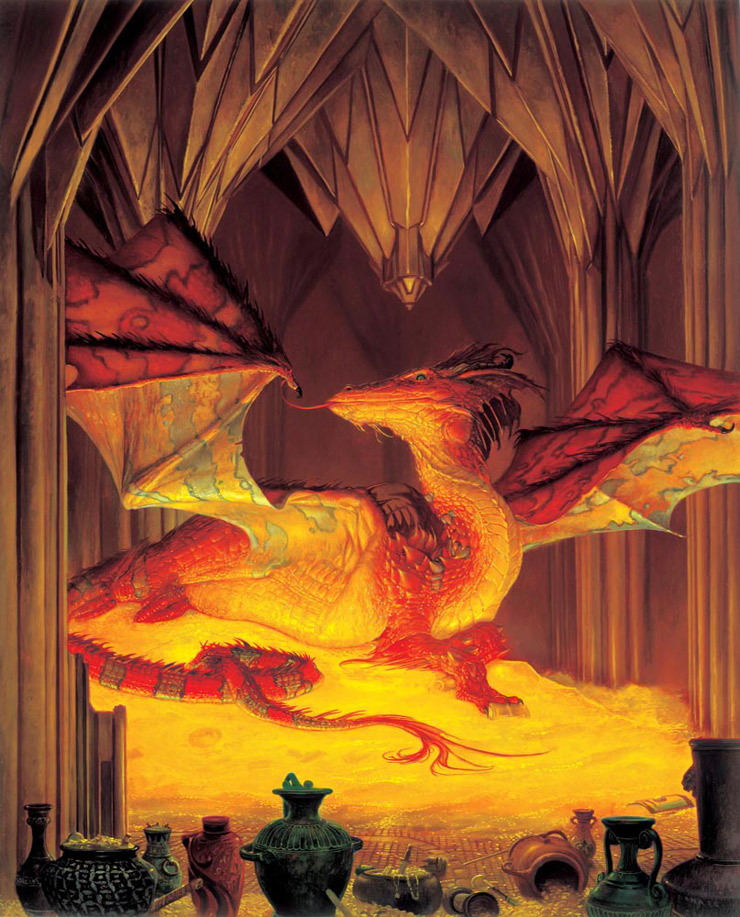
The Dwarves go on to war with the Orcs who occupy Moria, and that doesn’t go well, either. After the subsequent death and disappearance of its most recent heirs, one Thorin Oakenshield becomes the new king-in-exile of his people.
Gandalf, freewheeling maverick that he is, sneaks into Dol Guldur again and this time confirms the presence of Sauron. Yikes! He then tells the White Council about it, but still Saruman overrules any decision to attack the Enemy there. Why? Because now the White Wizard regards Sauron as a true rival; he wants the One Ring for himself, and he now knows that Sauron is actively searching for his lost treasure. And if the Dark Lord’s spies are picking up clues, then maybe Saruman can piggyback on that and scoop the Ring up first.
But Gandalf won’t wait forever. He doesn’t know of Saruman’s secret lust for the One Ring, but the Grey Pilgrim can’t be tied down. He keeps doing his thing, and one day has a chance encounter with Thorin Oakenshield near the village of Bree. Not liking the overall state of things in the North—the presence of Smaug, the dragon’s desolation, and the resultant accessibility of Angmar to servants of the Enemy, Gandalf decides to set some things into motion.
So now we can insert the entire plot of The Hobbit: Bilbo emerges as the hobbit of the hour, scores the One Ring from Gollum without knowing how a big a deal that is, and helps the Dwarves of the Lonely Mountain win back their home through both hapless and volitional choices. Thorin Oakenshield becomes King Under the Mountain, Erebor is restored as one of the great Dwarf kingdoms of the age, but at the cost of far too many lives.
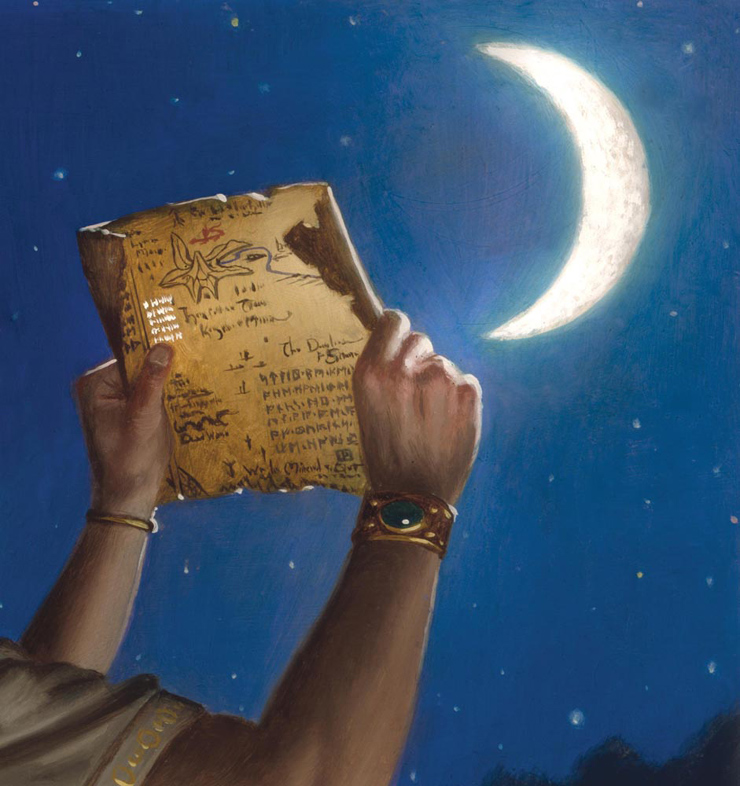
Meanwhile, the White Council finally listens to Gandalf and decides to take action…which is to say, Saruman finally lets it take action. Why? Because Saruman thinks the Dark Lord is now getting too close to finding the One Ring. By this point, Saruman has already learned that the Ring disappeared in the Gladden Fields, and that’s where Sauron has had his spies searching. Time to kick him out of there. So as a united force, the White Council advances into Dol Guldur and gives the Enemy the boot. Which Sauron is actually fine with, this time. He’s all, “Oh no, you found me! I’d better run!” He flees dramatically but then goes, nice and quiet-like, to Mordor again. Time to oversee the reconstruction of Barad-dûr.
Now, in the wake of Bilbo’s adventures, the One Ring is in the Shire! And Gandalf ain’t telling nobody about his little friend’s new prize. Best to keep it way down on the down-low. He knows it’s probably a Ring of Power, but he doesn’t yet think it can be the One Ring to Bind Them. Maybe it’s one of the lost Seven, or one of the many other lesser rings made by the Elves in the Second Age. Either way, the Shire and its people need looking after. And since Gandalf is friends with the Rangers—because of course he is!—he asks them to “set a watch upon the land of the Periannath.”
This part of this chapter, and the whole legendarium, makes me think of Melian’s words to Galadriel back in the First Age, back when Men first showed up in Beleriand:
Now the world runs on swiftly to great tidings.
It’s not like the Third Age has been quiet. Obviously, it hasn’t. Men and Dwarves have been warring with the messy remnants of Sauron’s once-great power, while Elves stay vigilant even as their role in Middle-earth has dwindled to almost nothing. But now Sauron is really ramping up. Time has been on his side as an immortal Maia of Morgoth’s tutelage. Now he’s regained enough of his former power to truly search for the One Ring. First he captures Gollum, and learns that his precious treasure has indeed been found! Time to prep the Nazgûl for some recon!
If Sauron gets his Ring, the world of Men will go down hard. I mean, who can stop him? There’s no Gil-galad this time, no Elendil the Tall, no Last Alliance. The Elves are too weak and too few, and the blood of Númenor? Gone.
Oh, wait. There is that one line of Dúnedain chieftains whose ancestry runs back all the way through the Kings of Númenor, and the original Elf-friends of old, and Eärendil himself, and thus to all the different kindreds of the Eldar, not to mention Lúthien and her Maiar mom.
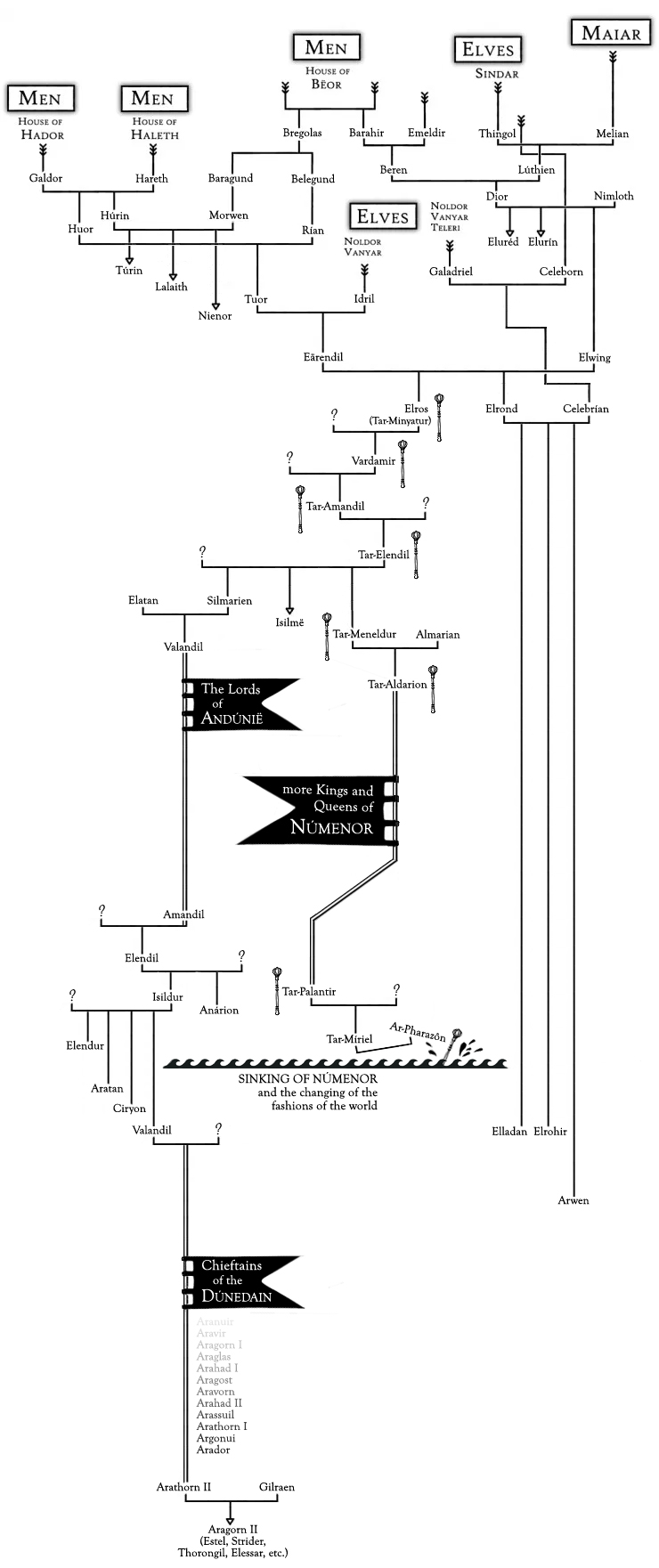
The latest of this line is young Aragorn II, son of Arathorn II. Arathorn is taken out of the picture the same way Tuor’s dad was (Orc-arrow in the eye!), and so his boy is fostered by Elrond in Rivendell. When he comes of age, Aragorn learns of this heritage, and the weight of history falls upon him. Like Beren, a high doom is on him, and also like the One-handed he meets and falls in love with an Elfmaid of supremely higher lineage: his foster dad’s daughter! It happens in a similar fashion, too.
But to win Arwen’s hand, he’s got a lot to do. And again like Beren, Aragorn’s got a rough road ahead, to achieve a seemingly impossible task, which is set before him by Elrond (but at least not handed to him in a wrathful, Thingol-like way). Instead of retrieving a holy gem from the headgear of an evil Vala, this scruffy Ranger who “looks foul and feels fair” must gain the throne of Gondor and unite the North to challenge the great Enemy and save the world. That’s all.
Aragorn starts by going out into the wild, and the wider world, where he earns more names and titles than Túrin Turambar—if that can be believed. He helps many people against the rising shadows of Mordor. Under a slew of aliases he fights in Rohan, he fights in Gondor…
and went alone far into the East and deep into the South, exploring the hearts of Men, both evil and good, and uncovering the plots and devices of the servants of Sauron.
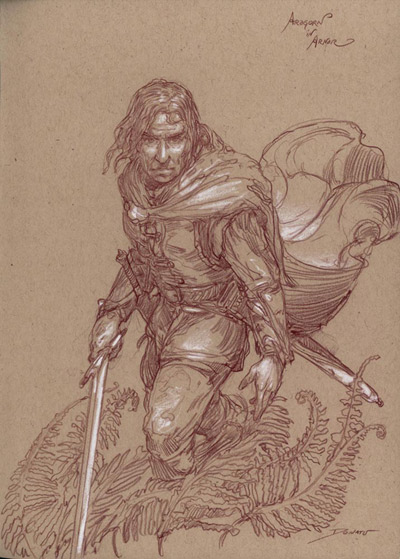
History will rightly compare him to his First Age forebears. But then he circles back and settles into the role of Ranger whom the Men of Bree call Strider. And his friend Gandalf even enlists his help to keep an eye on things near the Shire.
And now at last we can drop into this exposition the full plot of Tolkien’s most famous novel, Of the Halfling’s Trove and the Fall of Sauron. No, sorry, I’ve grown too accustomed to Silmarillion chapter titles. Rather, The Lord of the Rings, wherein Frodo, while he still has ten fingers, steps up and takes Bilbo’s funny magic ring on a big adventure.
There’s loads of action even early on: a big birthday bash, fireworks, discussion of real estate at Bag End, the intervention of a singing forest-weirdo, and freaky barrow-wights. There’s even some chase scenes.

Saruman finally reveals his true and Many Colours and tries to keep that nosey-posey Gandalf from keeping the One Ring out of his hands. But Radagast busts his old friend out—indirectly and unknowingly—with the help of the Third Age’s foremost Eagle.
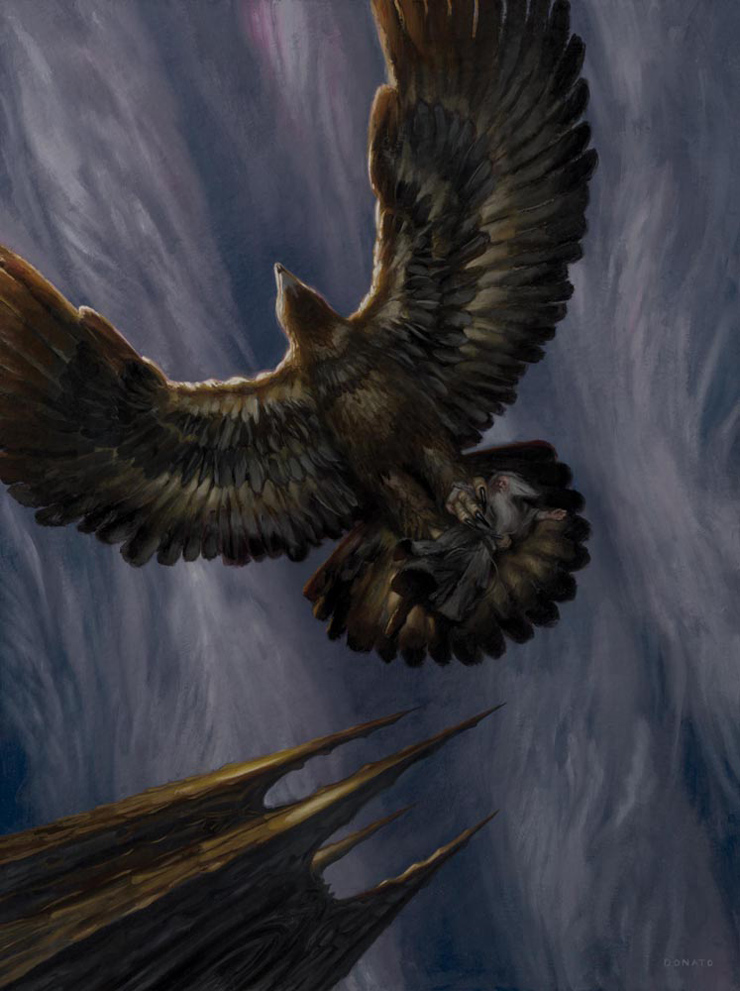
Frodo goes on to meet some really cool people. After chilling in Rivendell, he travels in style with a nine-fellow Fellowship: there’s a Man of Gondor, a Dúnedain Ranger, an Elf-prince of the Woodland Realms, a Dwarf of Erebor, one Istar, and three of his Hobbit buddies. If things weren’t so precarious for the world, this would be the ultimate party-time road trip!
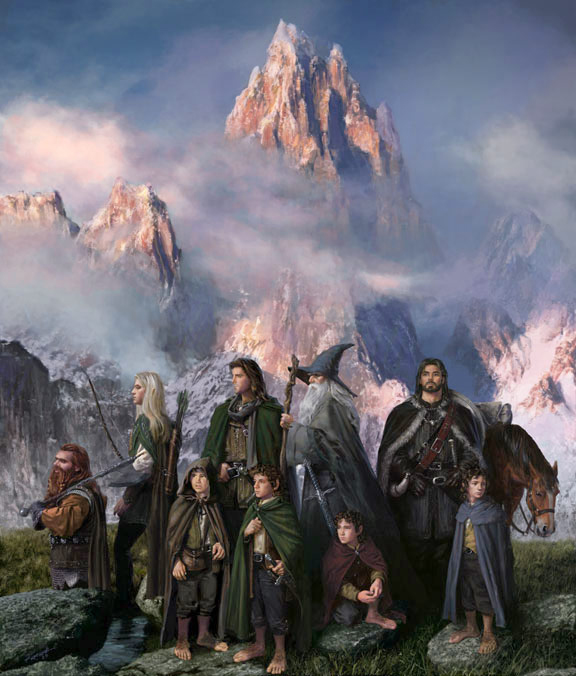
They end up walking a lot—and through some really rough weather, too.
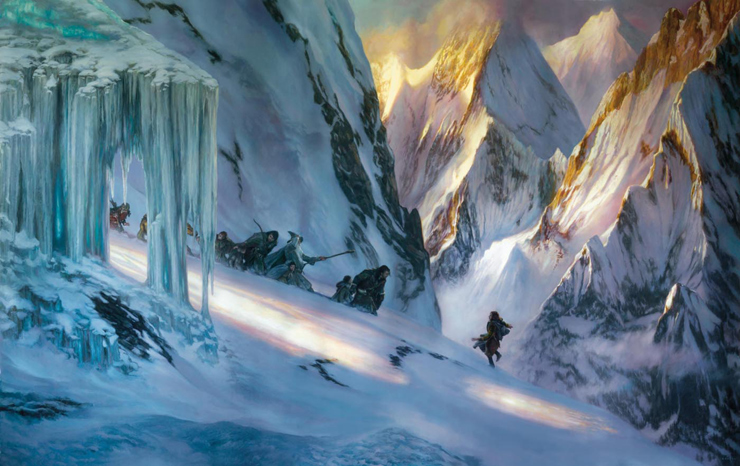
And no, they can’t just ride Eagles the whole way. That’s for damned sure. Those’re Manwë’s special ops.
They (temporarily) lose their Istar, but it’s only because he tangles with Durin’s Bane—you know, that Balrog from the old gang back in Angband—in the deeps of Moria. That’s right. Gandalf has to do the work of five Maiar.

Then the Fellowship go on to meet Galadriel, and Frodo is totally “the footsteps of doom” to her. Because even if he succeeds in getting rid of Sauron’s Ring, her own Ring of Power will lose its potency. Then Lothlórien and all her tarrying in Middle-earth will be ended. Poor Galadriel; for thousands of years, ever since Valinor, all she ever wanted was go to Middle-earth and rule over a realm of her own. Now she’s finally done it, kinda sorta, and then this little Halfling comes along to presage the end of it all. Girl can’t catch a break.

Lucky for us, she’s one of the good ones—and only with her help do these now-eight fellows, laden with gifts and good advice, go on with renewed courage. But soon after, they lose another friend, the Man from Gondor. The incident bums them all out and even splits up their party.
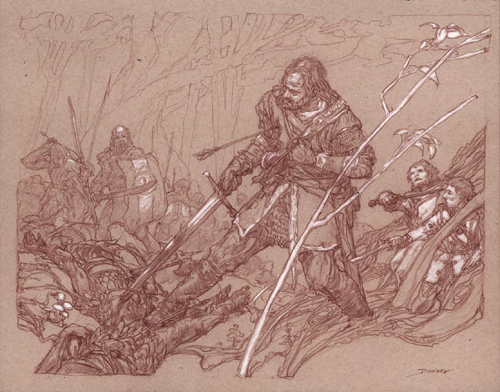
Then Frodo and his gardener run into Gollum and the trio get along…well enough, I guess. Sure, the relationship has some rough patches. At one point, Frodo’s even forced to use a bit of secondhand Silmaril-light from Eärendil’s headlamp to stave off Ungoliant’s last kid. (Thanks, Galadriel, for bottling that up for him!)
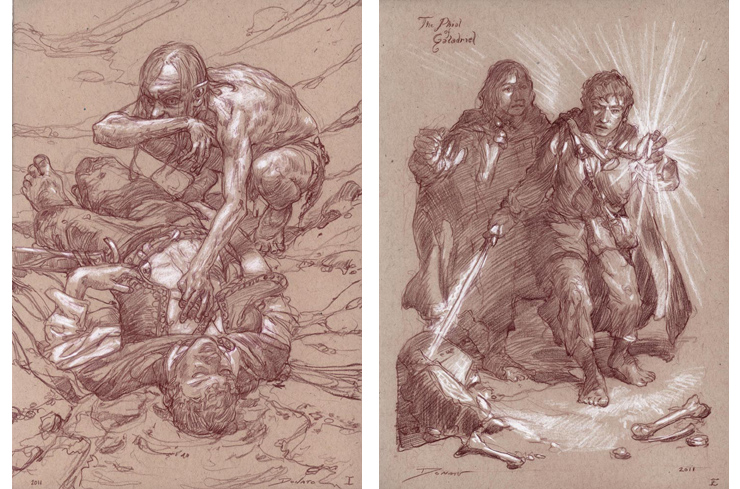
But then the remaining Man, Elf, and Dwarf of the group jog through Rohan and scuffle with Saruman’s own brand of Orcs. Which…c’mon, Saruman! This is basically the opposite of what you agreed to do in Middle-earth! Such a jerk.
Then Frodo’s cousins meet the shepherds of the trees! See, Yavanna totally called it: the Ents were in the Song (the Music of the Ainur itself), and now it turns out they have a big part to play in negating the threat posed by Isengard’s rogue Maia. You go, Giver of Fruits!
So yay, Ents are back on the scene! This time they’re more than just bit players. (We’ve not seen them since their cameo in “Of the Ruin of Doriath”!)
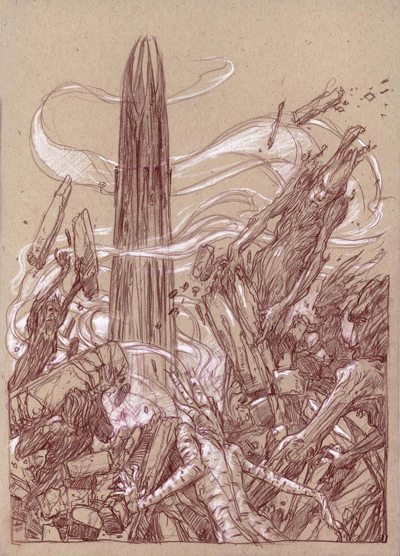
Later, when the leader Ent meets the Dwarf of the hour, I bet Yavanna and Aulë exchange knowing, nervous looks, way over in Valinor. But it turns out okay. They’re all friends now.
Then things move at last to Gondor, where Minas Tirith is still being pestered by the forces of Mordor. But behind the scenes, Aragorn, the heir of Isildur, and a ragtag group of Rangers go and summon those good-for-nothing Oathbreakers that Isildur cursed back in the Second Age. Now at last they are good for something; they redeem themselves, and this allows Aragorn to join the party, with force, on the fields in front of Minas Tirith.
And it’s right there on that field of battle that the Witch-King finally gets what’s coming to him—his just desserts.
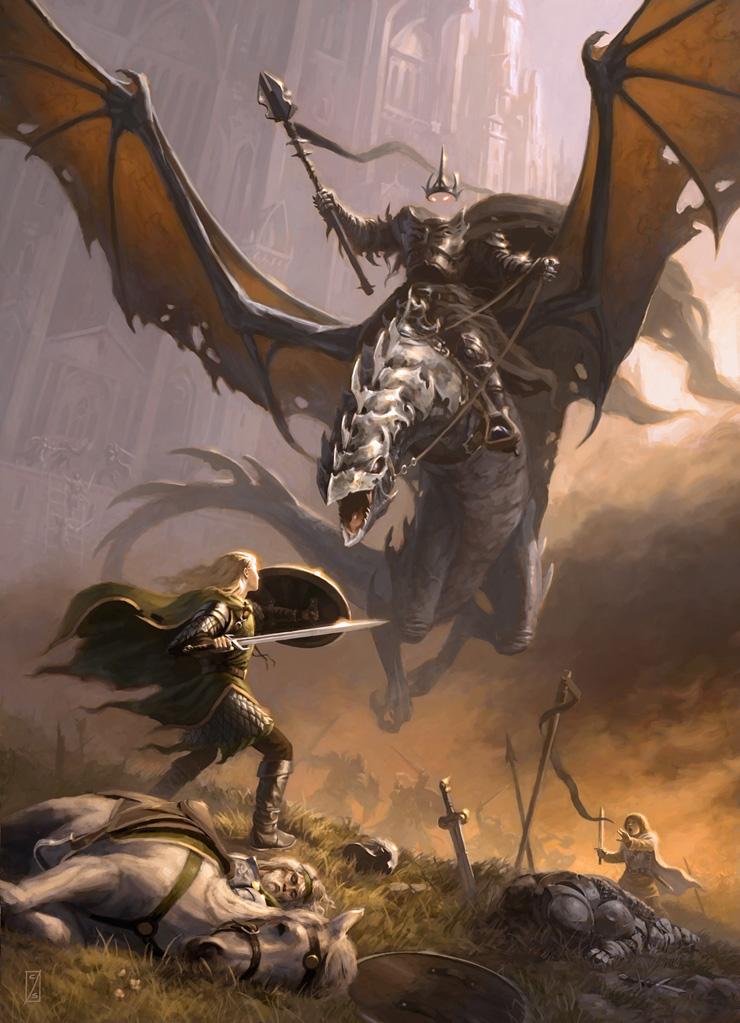
” by Craig Spearing
Which is to say, one of those shield-maidens of Rohan comes between the Nazgûl and his prey and then hinders the shit out of him (with a timely assist from a nearby Hobbit friend).
If the Witch-king had been able to chit-chat with his boss afterwards (not a chance), Sauron might have commiserated and told him about the time he seriously underestimated a girl in the First Age. It’s almost like the bad guys don’t take the women of Middle-earth seriously enough, either. Well, too bad for them. But it’s not like they didn’t have precedence for this. Morgoth himself feared Varda, the Lady of the Stars, above anyone. And now, somewhere, Melian is probably rolling her eyes…and cheering!
But anyway, Frodo and his gardener slog into Mordor at last, bearing the One Ring to the last place in the world that Sauron would look, and which Isildur once had so close at hand: Mount Doom!
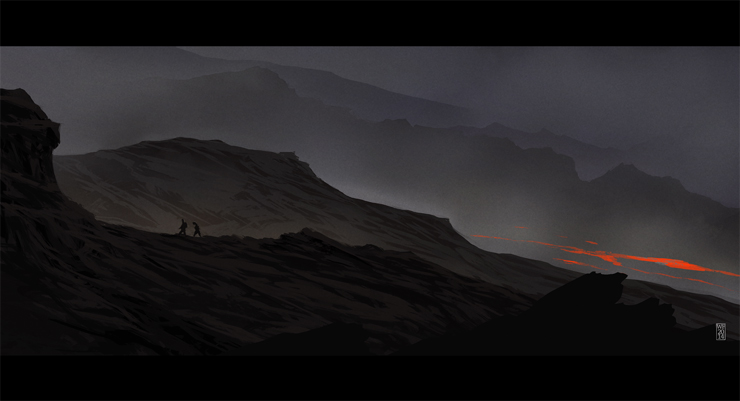
There, the Hobbits get the job done at last. It isn’t easy, and Frodo falters in the end. But because of the pity he learned from Gandalf (who in turn learned from Nienna!) and also because of his own Ring-based contingencies, he’s made sure that Gollum is there at the eleventh hour to bite off the offending finger.
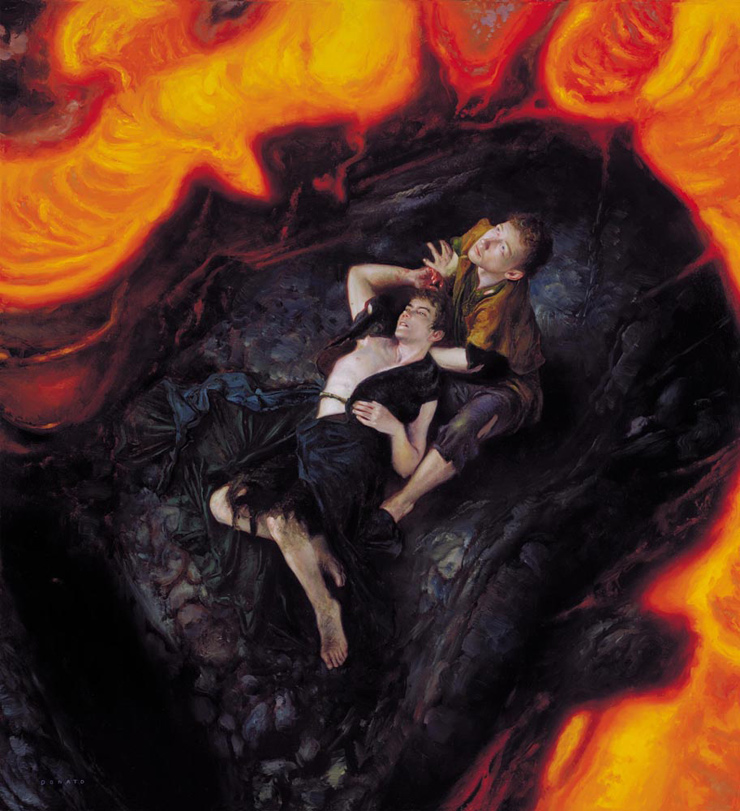
The One Ring To Rule Them All is therefore unmade. Barad-dûr and its foundations crumble at last, and the Dark Tower’s chief occupant is reduced to an impotent shadow of malice. The Hobbits have saved the Shire! And the whole mortal world.
Aragorn unites the lands under the banner of Gondor and Arnor, so he gets to marry his foster dad’s Elf-daughter. His wife then makes the same choice as Lúthien, so she, too, will be counted among Men and go beyond the Circles of the World when she dies.
Gandalf then helps Aragorn find a surviving seedling of that White Tree, so it flowers and grows again. Yay! Then Gandalf’s irresponsible former supervisor, Saruman, sticks around long enough to cause some further trouble in the Shire. It’s rather pathetic. The bad Maia is reduced to merely pushing around Hobbits in their homeland, but they thwart him in the end without even needing help from any Men, Elves, or other Istari.
Though they are mere mortals, Frodo and Bilbo are eventually grandfathered into the Valar’s Elves-only policy of sailing on the Straight Road to the Undying Lands. As former bearers of the One Ring, they’ve suffered much and earned a special place in paradise, short-lived as it may be for them. Círdan is cool with this, and anyway all of the Wise are departing, too. Footsteps of doom, and all that.
But of course, anyone reading this knows that part of the story. Yet The Silmarillion ends not like The Lord of the Rings, with the departure of Frodo and the return to the Shire of the hero-gardener of the age. It doesn’t merely end with the baton being handed off to Men as the Fourth Age begins.
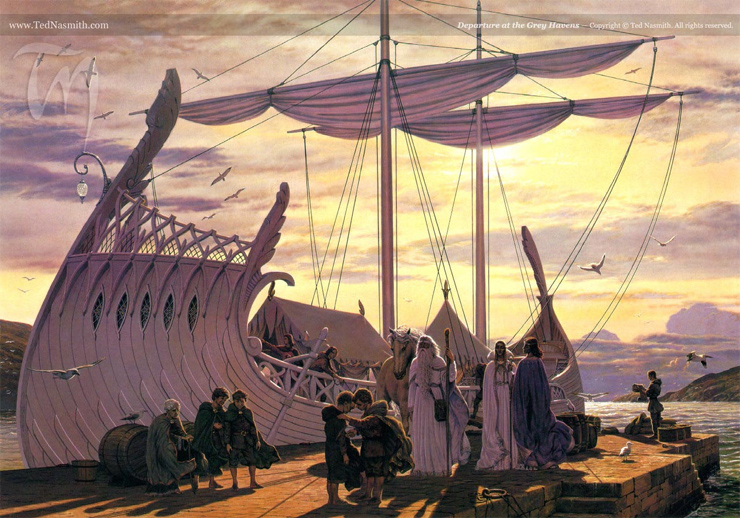
Remember, this book is chiefly the story of the Elves, especially of the Noldor. So it largely ends with the departure of the last of the Noldor, which would be Galadriel, Glorfindel, and maybe a few others. Galadriel really, really needs a family reunion in Valinor—her mom, her dad, her brothers! So much catching up to do. (She’ll be pleased to find out that Finrod finally settled down with a nice girl from the old country.) Interestingly, Celeborn stays behind for a while. He might even be the last of the Eldar to depart at some unspecified date.
But the book truly ends with the focus on Elrond, who is sort of the symbolic link between the Elder Days and this dawning age of Men. His dad is Eärendil the Mariner, who still sails the skies with a Silmaril strapped to his head; he is a symbol of hope for all of Arda, and his efforts helped bring Morgoth down in the First Age. Elrond’s brother was the first king of Númenor. And now his daughter is the neo-Lúthien of the age, who’s just married the last descendant of Númenor.
With the departure of Elrond Half-elven, loremaster of all the greatest legends of Middle-earth, things wrap up rather smoothly and symbolically.
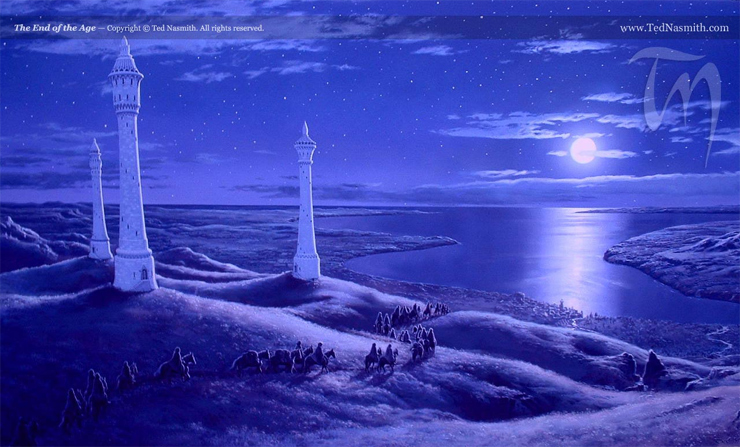
Although he’ll depart someday, too, Círdan the Shipwright does what Teleri Elves do best: he tarries a bit longer. He’s still standing on the shores of Middle-earth, waiting to pick up any stragglers—like, perhaps, Elrond’s twin sons, whose ultimate fate is mysterious, as they don’t leave when their dad does. (But it would be unsurprising to learn they stuck around a good long while, mopping up Orcs with grampa Celeborn.) It was Círdan who helped make the ship used by that whippersnapper Eärendil (before the Valar re-made it), so it’s only fitting that it’s he who made the ship that bears Eärendil’s boy into the West, too.
And so off Elrond goes, leaving the “Bent World” and its “round sky,” a very different place than it was when he was born! As the Straight Road lifts him towards the Uttermost West, I like to think he sails past Vingilot and gives a thumbs up to Pops on the way out.
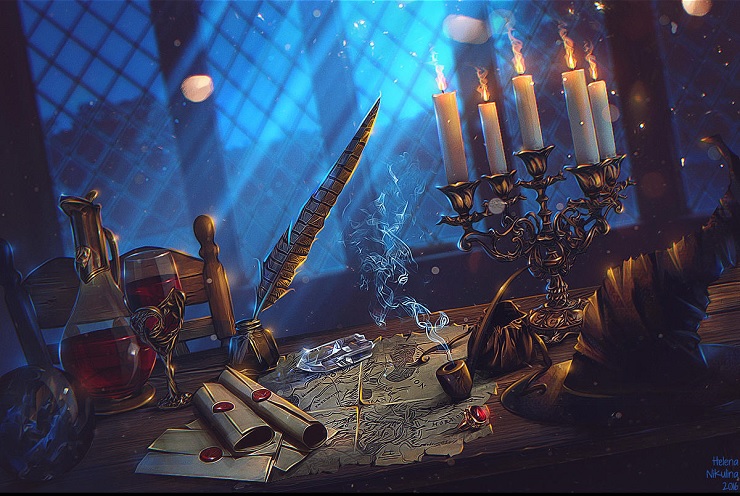
Well…that’s it, folks!
I’d really like to thank you all for reading along in this series, as well as all the amazing artists who gave me permission to share their work. And even more especially my brother, John, for his general proofreading and often-specific witticisms throughout. But I’d also like to point out, again, that The Silmarillion (like any of Tolkien’s books) is the sort of work that will eternally fascinate and offer new nuggets (nay, gems) of insight with each revisit. Does that mean should you flip back to page 1 and start with the Ainulindalë all over again? Not necessarily.
Go listen to some fun people talk about it first. Then read some other stuff. Then come back to it. And I do have recommendations, podcasts that have inspired me, like the ones hosted by Dr. Corey Olsen: The Tolkien Professor, Mythgard Academy, Mythgard’s Exploring The Lord of the Rings, etc. Then there’s…
The Prancing Pony Podcast: These guys traversed The Silmarillion in their first season. In Season 2 they walked along with Bilbo in The Hobbit, and now in Season 3 they’ve only just begun down the road that goes ever on and on in The Lord of the Rings. Alan Sisto (the Man of the West) and Shawn Marchese (the real-life Lord of the Mark) are a blast to listen to…provided you can handle that much dad humor.
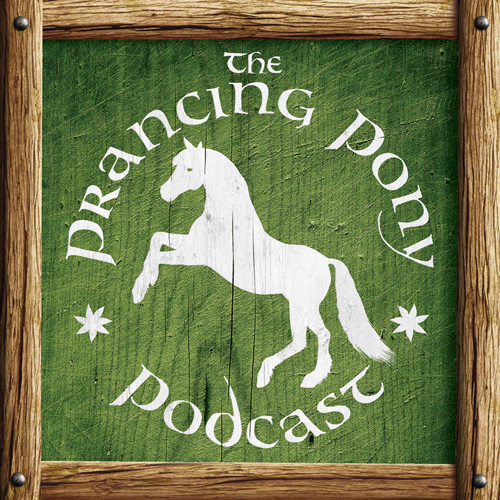
The Green Door Podcast: Very much worth your time! This trio of podcasters (two Canadians and a Brit) are much newer, and have only recently delved into The Silmarillion. While they’re not walking through it moment by moment, James O’Flaherty, May K. Hella, and Adam “Ads” Hillier really throw themselves into some wonderful discussions—offering some refreshing and original points of view on Tolkien’s tales. I even “guest starred” in Episode 12 via palantír. They’re a lot of fun. Is it possible to seem and feel fair? They do.

Anyway, all of the above ensures a steady stream of never-ending Tolkien discussions. There’s no such thing as tarrying overlong in Middle-earth.
Top image from “The Fellowship in Hollin” by Donato Giancola.
Jeff LaSala can’t leave Middle-earth well enough alone, and will probably look for more excuses to keep talking about it. His follow-up series Deep Delving into Middle-earth continues the theme of Tolkien excavation. Tolkien geekdom aside, Jeff wrote a Scribe Award–nominated D&D novel, produced some cyberpunk stories, and now works for Tor Books. He sometimes flits about on Twitter.










